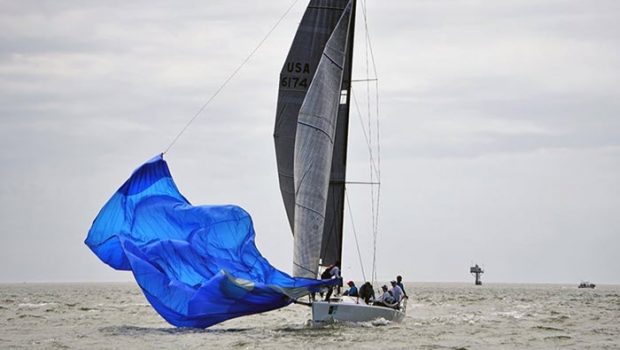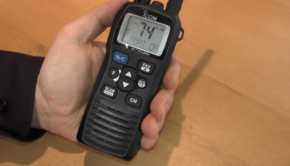Spinnaker mishaps and how to fix them
Published on July 28th, 2022
While spinnaker trouble can provide for a good bar story, it doesn’t lead to good results. Quantum’s Will Paxton explains not only how to get out of a mess if it happens, but also how to help prevent one from happening in the first place.
“An ounce of prevention is worth a pound of cure,” wrote Benjamin Franklin. He was talking about fire safety, but this saying applies to sailing as well. In our case, the pound of cure is through preparation and training.
Yes, we will have mishaps, but preparation and training can help us recover from them. Here’s how to apply preparation and training to three common spinnaker mishaps: shrimping, the hourglass twist, and wrapping around the forestay.
Tradecraft happens when crew members know their “trade” and the details of their positions. It starts with leadership making sure that the crew knows their roles and expectations. Tradecraft is achieved through a training routine that involves repetition of maneuvers to capture the nuances and potential pitfalls of any activity on the boat, from tacking and trimming to dousing and hoisting.
Well-prepared crews are able to communicate clearly and quietly, even non-verbally, to ensure smooth execution of maneuvers and tasks. Repetition will also enable crew to respond more efficiently when mishaps occur.
Here’s how to prevent and recover from the three most common spinnaker mishaps.
#1: SHRIMPING
Shrimping happens when the kite is doused and the tack ends up in the water, sometimes under the boat, and your crew ends up looking like they’re pulling in a shrimp net. Not surprisingly, shrimping is slow going.
If sailing to an anchorage or in a race, you want to avoid shrimping or recover as quickly as possible. There are a few things that can be done to prevent or quickly recover from shrimping if it happens. Again, the key to prevention is tradecraft.
Prevention
The most important step in preventing shrimping is to keep the tack out of the water. Part of the bow person’s tradecraft is following the foot tape to do exactly that. By holding the foot tape up as the tack comes back, the bow person prevents it from going into the water. The mid-bow or mast person’s job is to gather the back end of the kite.
A fouled or cleared tack line is something that can both cause a shrimp and make it hard to recover. The pit or cockpit crew must make sure the tack line is clear to run and that there are no kinks or knots including stopper knots)preventing it from coming back on the douse or from being able to run free if you get into trouble.
Having a long tack line will help prevent losing it overboard, so I recommend you not try to save money by having a shorter tack line with a stopper knot in it. If the tack line fetches up because it’s too short or caught at a clutch or cleat, the kite will fill with water and go right under the boat.
The trimmer pulls the sheet in and allows the foot to run back due to the free tack line, they grab the clew and haul the kite in. The pit is watching the douse and controlling the speed to ensure that the foot doesn’t go into the water.
Recovery
If your kite does shrimp, here’s how to recover. The pit person should immediately stop the douse by closing the clutch or re-cleating the halyard. By stopping the douse, you limit the amount of water the kite can catch. Once that is done, blow the tack and try to re-hoist the kite. Letting the tack line run helps to prevent the foot from catching water and dragging the sail down.
This is why you don’t want to have knots or kinks your tack line. If the tack line isn’t loose, the foot will act as an anchor and complete stop the boat, making it difficult to get the kite onboard. With the halyard up and tack line loose (even free flying), the kite will trail alongside the boat, letting all the water out of the foot and enabling the crew to pull it onboard.
Once a shrimp has occurred, the trimmer should hold onto the sheet. When the tack line is blown, only the halyard and sheet keep it attached to the boat. The bow person helps gather the kite and allow water to run out of the loose foot. The mid-bow or mast person must gather the after-portion of the kite after getting it out of the water.
After a shrimp, the kite is pulled aboard by the sheet as the tack runs freely back, spilling any captured water. The pit person controls the douse, enabling the crew to gather and bring in the kite. Once the kite is back onboard, the bow person can re-run the tack line if needed. The kite should be inspected quickly to see if there is any damage. Then repack and prep it for the next hoist.
#2: THE HOURGLASS TWIST
This is probably the most common mishap teams and crew will deal with. Hourglass shaped twists happen when the tack isn’t made fast enough and the clew is too loose; the leech gets caught in the air coming off of the main in tight spirals, causing it to blow the wrong way and the kite twists up into the tell-tale hourglass.
Prevention
Hourglass twisting can be prevented with a cleanly packed kite. The pit person should run the tapes before the first hoist and make sure the head, tack, and clew are all clear to hoist without twists. Again, this is tradecraft. After every douse, quickly run the luff to ensure that it came down cleanly.
Preventing the dreaded hourglass also involves the hoist. As you quickly feed the tack, keep the slack out of the sheet so that the clew and mid-leech stay away from the luff of the sail. You don’t want to pull the sheet, but make sure you’ve got control of it. This will help keep the leech and spinnaker body from falling victim to the swirling air coming off the main, especially in big breeze.
Prevention also has to do with sail age and material quality. All spinnaker material comes with a thin silicone coating that makes them slippery and easy to run. As they age, they lose this coating and become increasingly difficult to smoothly set and douse. If you find that you’re wrapping your kite on a regular basis and it’s seen a number of seasons, it is likely time for a new kite.
Recovery
When hourglass wrapping happens (yes this one is a when, not an if), resist the urge to pull down on the clew. Communicate to the pit to stop the hoist as soon as you notice the twist, and pull the clew out as the bow person or mid-deck person pulls down on the center of the foot.
If this becomes too hard, have the pit person slowly lower the halyard as you continue to pull out on the clew and down on the center of the foot until the twist is fixed. Worst case, you will need to lower the sail onto the deck and fix it by hand.
#3: WRAPPING AROUND THE FORESTAY
Another major mishap is wrapping the kite around the forestay. Usually a wrap starts with a leeward collapse. You’ll either surf over the spinnaker or the spinnaker collapses and gets into what I call the ‘rotor’ behind the main–where the air is swirling downwind of the mainsail. That air is coming around the backside of the main sail and can make the spinnaker blow to weather around the headstay and start wrapping in the vortices behind the sail.
Prevention
To prevent a wrap, head up and pull in the active sheet. This should cause the kite to blow back through the foretriangle. This often happens during night sailing when it’s hard to see what’s going on up there and your reactions may be slower. You have to recover quickly. (Wraps can also happen after a bad gybe in heavy air.)
Recovery
Try to Over-sheet the main sail and to get the wind to blow the other way behind the main. This will help reverse the air behind the sail and start blowing the wrap out the other way. The other thing you can do is to gybe the main. Again, you are trying to get the vortices that wrapped spinnaker to go the other way and start unwrapping it.
BONUS TIPS
• I highly recommended using a ceramic knife as your cockpit knife. It doesn’t rust, is extremely sharp, and inexpensive. In windy conditions, when the kite shrimps and gets “bar tight” due to a knot or kink at a clutch or cleat, you can cut the tack line to free the kite and prevent anything worse from happening. (You don’t want to allow the loaded kite to damage the rig or carry a crew member overboard.) A ceramic cockpit knife can cut the tack line easily.
• Keep a spare spinnaker sheet to use as a new tack line if needed. It’s always a good idea to have a spare sheet on board, anyway, but it’s particularly useful if you end up in a worst case scenario and lose your original tack line.









 We’ll keep your information safe.
We’ll keep your information safe.